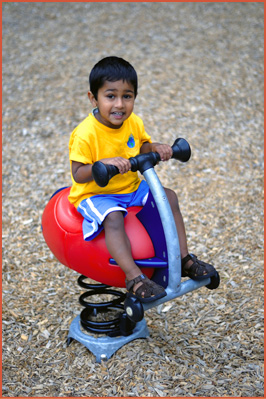

| • Stages of Play • Benefits of Play in Children’s Development |
|
Importance of Play Spontaneous play is natural and healthy for children. Children learn best through play. Through play all areas of a child’s development can be enhanced. Play positively supports children’s social/emotional, physical, cognitive, language, and literacy skills, is essential to a child’s overall healthy development (Ginsburg, 2007; Packer Isenberg & Quisenberry, 2002) and enhances self-regulation. Daily physical and active play for children is recommended by the Canadian Paediatric Society (Grenier & Leduc, 2008), to foster optimal development. The right to play is also recognized for all children in the United Nations Convention on the Rights of the Child (1989). Hirsh-Pasek et al. (2009) states that “play offers a key way to support the learning of whole children in developmentally appropriate play” (p23). Play, therefore, is an important vehicle that promotes children’s school readiness. |
 |

- Locomotor play - physical
- Social play - social/emotional
- Pretend play - social/emotional
- Object play - cognitive
- Language play - language and literacy
(Smith & Pellegrini, 2008)
- Infants engage in solitary-functional play
- Toddlers engage in parallel-functional play
- Preschoolers engage in associative play, constructive play and dramatic play
- Four and five year olds engage in cooperative-constructive play, socio-dramatic play and begin to play games with rules.
- Kindergarten and school age children elaborate cooperative-constructive play, socio-dramatic play and games with rules.
Functional play includes the investigation of the properties and functions of objects through sensory motor exploration. When we are introduced to a new medium like clay for the first time we all may pinch, poke and pull apart the clay in functional play. When children are “stuck” using functional play and do not move with time and experience from poking, pinching and pulling clay to rolling it and forming shapes and eventually creating objects then it may be time to intervene.
- The child is being isolated by peers
- The child has some emerging interest and social skills
- The child chooses to play alone
- The child needs some assistance to move beyond the present form and level of play.
- Play enhances children’s creativity and problem-solving (Smith & Simon, 1984).
- Play contributes to the development of self-regulation and social skills such as turn-taking, collaboration and following rules, empathy, and motivation (Bodrova & Leong, 2007; Krafft & Berk, 1998).
- Children, who engage in social and dramatic play, are better able to take others’ perspectives, and are viewed as more intellectually and socially competent by their teachers (Connolly & Doyle, 1984; Sawyer, 2001).
- Outdoor play helps to promote children’s physical well-being, attention, conflict resolution, coordination, muscle development, and healthy weights (Clements & Jarrett, 2000; Council on Physical Education for Children, 2001; Fjortoft, 2001; National Association of Early Childhood Specialists in State Departments of Education, 2002).
- Adding literacy-related materials to dramatic play centres, increases reading and writing activities and use of more varied language (Bagley & Klass, 1997; Neuman & Roskos, 1997; Stone & Christie, 1996).
- Children, who play out events in a story, have improved story comprehension and develop a stronger theory of mind, the understanding that others have different feelings, thoughts, views and beliefs (Pellegrini & Galda, 1980).
- Positive links between children’s dramatic play and early reading achievement have been found (Pellegrini, 1980).